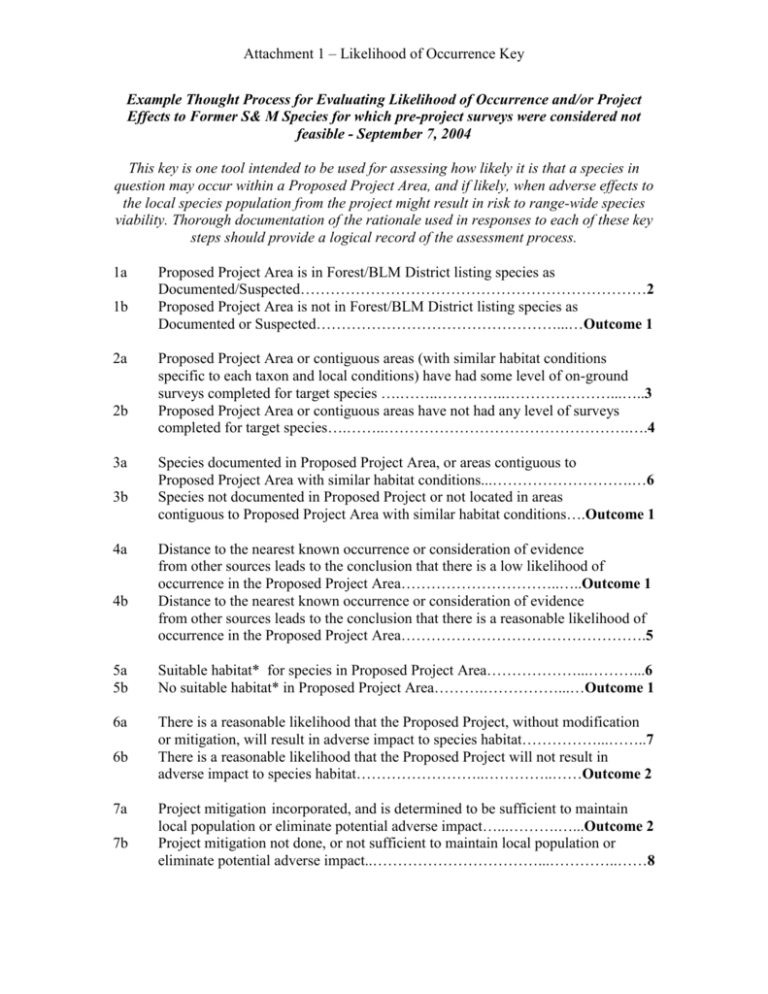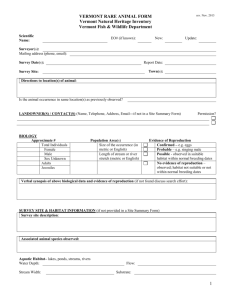Attachment 1 - Likelihood of Occurrence Key
advertisement

Attachment 1 – Likelihood of Occurrence Key Example Thought Process for Evaluating Likelihood of Occurrence and/or Project Effects to Former S& M Species for which pre-project surveys were considered not feasible - September 7, 2004 This key is one tool intended to be used for assessing how likely it is that a species in question may occur within a Proposed Project Area, and if likely, when adverse effects to the local species population from the project might result in risk to range-wide species viability. Thorough documentation of the rationale used in responses to each of these key steps should provide a logical record of the assessment process. 1a 1b 2a 2b 3a 3b 4a 4b Proposed Project Area is in Forest/BLM District listing species as Documented/Suspected……………………………………………………………2 Proposed Project Area is not in Forest/BLM District listing species as Documented or Suspected…………………………………………...…Outcome 1 Proposed Project Area or contiguous areas (with similar habitat conditions specific to each taxon and local conditions) have had some level of on-ground surveys completed for target species ….……..…………..…………………...…..3 Proposed Project Area or contiguous areas have not had any level of surveys completed for target species….……..………………………………………….….4 Species documented in Proposed Project Area, or areas contiguous to Proposed Project Area with similar habitat conditions...……………………….…6 Species not documented in Proposed Project or not located in areas contiguous to Proposed Project Area with similar habitat conditions….Outcome 1 Distance to the nearest known occurrence or consideration of evidence from other sources leads to the conclusion that there is a low likelihood of occurrence in the Proposed Project Area…………………………..…..Outcome 1 Distance to the nearest known occurrence or consideration of evidence from other sources leads to the conclusion that there is a reasonable likelihood of occurrence in the Proposed Project Area………………………………………….5 5a 5b Suitable habitat* for species in Proposed Project Area………………...………...6 No suitable habitat* in Proposed Project Area……….……………...…Outcome 1 6a There is a reasonable likelihood that the Proposed Project, without modification or mitigation, will result in adverse impact to species habitat……………...……..7 There is a reasonable likelihood that the Proposed Project will not result in adverse impact to species habitat……………………..…………..……Outcome 2 6b 7a 7b Project mitigation incorporated, and is determined to be sufficient to maintain local population or eliminate potential adverse impact…...……….…...Outcome 2 Project mitigation not done, or not sufficient to maintain local population or eliminate potential adverse impact..……………………………...…………..……8 Attachment 1 – Likelihood of Occurrence Key 8a 8b Habitat requirements are too broad or too poorly understood to reasonably mitigate adverse effects through management of habitat at the project specific scale; or there appears to be an adequate proportion/amount of suitable habitat in reserved allocations to provide for viability of the species or to ensure that the project would not contribute to the need to list…………………...……Outcome 2 Above conditions not met………………………………………………Outcome 3 *Refer to Conservation Assessments, Conservation Guidance Measures, and Survey Protocols for guidance on suitable habitat. These documents generally contain the most current habitat data available, especially for species for which surveys may be impractical. Local knowledge of habitats for these species can and should be used as a guide. Outcome 1: Low likelihood of occurrence; low risk to species viability or trend toward listing A) The species is not listed on BLM or FS Special Status Species Lists as either Documented or Suspected in Proposed Project area, or in contiguous areas with similar habitats OR: B) The species has not been located or there is no suitable habitat in the project area. OR: C) Sufficient survey has been completed locally to determine that the potential for species presence is very low within the Proposed Project Area. OR: D) The distance to the nearest known occurrence is substantial, and no local concentrations of the species are apparent. There is a low likelihood of occurrence, a low risk to species viability, and a low likelihood of ‘trend towards listing’ caused by the project. Outcome 2: Reasonable likelihood of occurrence; low risk to species viability or trend toward listing A) The species is likely to occur in the proposed project area. The project is not likely to result in adverse impacts to local species populations or their habitat because mitigation tailored to project actions has been completed or the project design/proposed action retains the key elements of habitat for the species (see mitigation discussion below). Although there is a reasonable likelihood of occurrence, there is a low risk to local populations or species viability, and a low likelihood of a trend toward listing caused by the project. OR: B) The species is likely to occur in the proposed project area, but habitat requirements are too broad or too poorly understood to reasonably mitigate adverse effects through management of habitat at the project specific scale. Broad-scale inventories with management of all known sites may contribute toward species viability. OR: Attachment 1 – Likelihood of Occurrence Key C) Allocated Reserve areas (Northwest Forest Plan allocations, as well as reserve areas designated elsewhere) could provide for viability of the species or could help to ensure that the project would not contribute to the need to list. Outcome 3: Reasonable likelihood of occurrence; higher risk to species viability or trend toward listing These sensitive species have very few sites and the project design has not eliminated a potential adverse impact to a site or to unsurveyed habitat that has a reasonable likelihood of site occurrence. Without other assessment tools or larger scale management strategies in place, the loss of the habitat may result in a higher likelihood that the project may cause a trend towards loss of viability or trend toward listing. Although not generally developed for individual projects, a conservation strategy could be developed for a larger area to ensure that neither loss of viability nor trend toward listing will result from project impacts. Consultation with line officers, and appropriate State Office/Regional Office staff is recommended to determine a course of action. When analysis of project impacts result in Outcome 3, application of appropriate mitigation measures may reduce the risk of loss of entire local populations, though it may result in the loss of some individuals. Many organisms share similar basic habitat requirements. All former Survey and Manage species are thought to be LateSuccessional Old Growth (LSOG) associates. The environmental conditions normally found within Late Successional Old Growth forests provide a basis for a model of basic habitat requirements for these species. Examples of characteristics that may provide the basis for a model of basic habitat requirements include: uncompacted soils with deep organic layers having a high water-holding capacity a stable microclimate (cool, moist, low light) high diversity of plant species multiple canopy layers large down woody debris that retains water, provides substrate and refugia, stores carbon, and accumulates nutrients (6) snags and large green trees that extend into the overstory and have late seral structural features such as deep loose bark, large diameter limbs, and cavities. (1) (2) (3) (4) (5) Maintenance of these conditions could be considered as general types of mitigation that may be applied to minimize adverse effects. For example, for a species known to be associated with down wood, measures could be taken to meet local Dec Aid requirements. Management guidance documents could be consulted for measures tailored to the area and the action.








